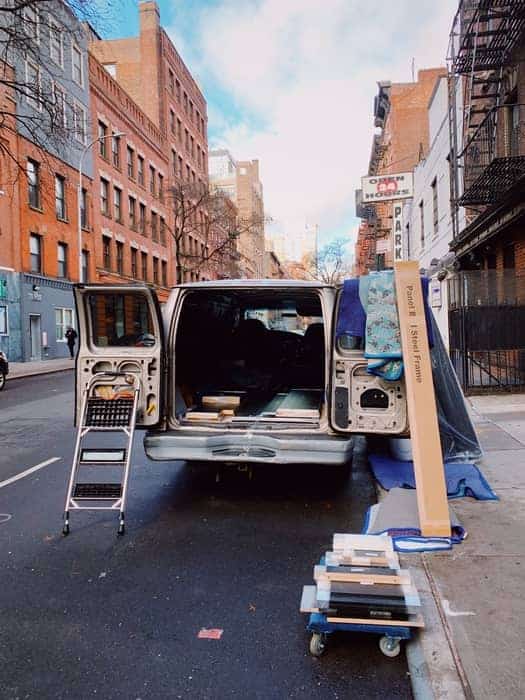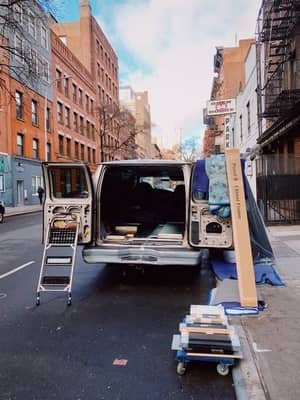
There are a lot of creative ways to get a motorcycle from point A to point B and people have come up with some of the craziest of methods. Safety should be the number one priority when transporting a motorcycle so it’s important that the method of transportation is thought out carefully.
One uncommon way many may wonder about is if it’s possible to transport a motorcycle using a van. Vans are great at hauling people and large items, but fitting a motorcycle inside may be a little different.
Can a motorcycle fit in a van? A motorcycle can fit in a van if the motorcycle is small enough and the back of the van is large enough. You may need to take out the back seats from the van completely and the handlebars on the motorcycle may need to be adjusted or temporarily removed. The motorcycle must be secured completely in order to use this method of transportation.
This is one of the nice things about owning a motorcycle; it’s small enough to fit in small spaces such as the back of the van. This article will explain exactly how to transport a motorcycle using a van and what safety precautions should be taken while doing so.
Fitting A Motorcycle In A Van
Thinking about having a motorcycle inside a vehicle almost seems a little weird; most people imagine a motorcycle being ridden on the open road or at least being hauled by some sort of trailer. But as crazy as it may seem, it’s completely possible to fit and haul a motorcycle inside a van and thousands of people do it every year.
Before considering hauling a motorcycle using a van, you’ll first need to consider the size of the motorcycle and the size of the van you’ll be using. You’ll likely have a lot more luck using a cargo van since they’re a little larger, but using a mini van is also completely possible.
Of course, the size of every motorcycle is different. For example’s sake, I’ll give some likely dimensions you’ll run into. The average large motorcycle is about 7 feet long, 3 feet wide, and 4 feet tall. This is including the average size of side view mirrors as well as the handlebars.
A lot of people end up using cargo vans to transport motorcycles because they’re the larger choice. Cargo vans are either used for moving those who live in a studio apartment or they can taxi a large amount of people, usually 12+. The average dimensions of the inside of a cargo van are 10.5 feet long (this is from the back door to the back of the driver’s seat), 5 feet wide, and about 4 feet tall.
As you can see, the length and width of a cargo van will easily be able to fit the average large motorcycle, however the height is cutting it close. You’ll likely have to either adjust the side view mirrors and/or handlebars or completely remove them in order for the motorcycle to fit. You’ll also want to make sure there’s some room between the top of the motorcycle and the ceiling inside the van so there won’t be any damage caused to either.
As I had mentioned earlier, it’s completely possible to use a mini van to transport a motorcycle, but the dimensions are a lot more strict which will likely limit you on what types of motorcycles will fit inside.
The average dimensions of a minivan is about 7.5 feet long, 5 feet wide, and just under 4 feet tall. As you can see, the dimensions are a little smaller than a cargo van. Every inch counts when fitting a motorcycle inside a van, so a minivan might be more appropriate for hauling a medium or small sized motorcycle. For other creative ways to transport a motorcycle, see my other article here.
Is It Legal?
Now that we’ve established that you can, indeed, fit a motorcycle inside a van, you may be wondering whether or not it’s okay to do so, or if you’d get in trouble with the law.
Some people want to fit their motorcycle in a van simply for long term storage while others want to fit their motorcycle inside so they have a more secure way of hauling it from one place to another. Fortunately in the U.S., trailering laws are somewhat lax. There are no laws prohibiting someone from transporting a motorcycle inside their van in the U.S.
There are many motor homes built specifically to haul toys inside, so it’s not unheard of to carry a recreational vehicle inside a larger vehicle. But if you’re being completely unsafe about the matter, you may find yourself getting a ticket.
For example, if you happen to get pulled over with a motorcycle in the back of your van, the policeman may want to double check and make sure everything is secure in the back. If you were careless about the way you strapped in your motorcycle, the policeman may deem you as a reckless driver and give you a ticket. So while it doesn’t seem to be illegal to fit a motorcycle in the back of the van, you can still get in trouble if you’re not being safe about it.
How To Safely Fit A Motorcycle Using A Van
Fitting a motorcycle in a van should be done with caution as well as with some help. I don’t recommend you make this a one man job, otherwise you risk damage to your motorcycle, your van, or both.
Make sure you take measurements of both your motorcycle and the inside of the van. Make the measurements yourself and don’t rely on what other people tell you or what dimensions you see online. Make adjustments to mirrors, handlebars, foot pegs, etc. if necessary. If there are any seats in the back, you’ll likely need to take them out so there’s room for the motorcycle and for you to walk around and secure it.
Before placing the motorcycle inside, find the points where you’ll be able to hook the straps to tie down the bike. If you had to take out the seats, the seat mount hooks on the floor will be perfect spots to hook those straps into.
It’s best to empty any fluids you may have in your motorcycle before loading it up in the van. Since you or someone else will likely be driving this van around, you’ll be in a confined space with toxic fumes that you shouldn’t be inhaling, especially while you’re driving.
You’ll need a reliable ramp to roll the motorcycle into the van. This is at least a two man job because it can be really awkward rolling the motorcycle up the ramp them trying to crouch down and roll the motorcycle inside a confined space. Make sure you have the appropriate help.
Once you have it inside, put the motorcycle in gear so it doesn’t roll around and strap it down securely (click here to see the tow straps I recommend in my list of suggested items to use while towing). Always use at least four straps to secure the motorcycle and try to strap the motorcycle down from it’s four corners if possible.
Once the motorcycle is strapped down, place either a tarp or piece of cardboard underneath the motorcycle to catch any leaks it may have. Even if you drained all the fluids, there’s probably some residual droplets somewhere so it’s better to be safe than sorry and not leave the carpet with fumy stains.
If there’s any risk of any parts of the motorcycle rubbing up against any part of the inside of the van, try using either a blanket or pillow and place it in between the two parts to reduce damage.
What About The Weight?
When fitting a motorcycle inside a van, it’s also a good idea to consider the weight of everything you’re putting inside. Vans do have a weight capacity, so make sure you take that into account before trying to fit a motorcycle inside.
The average motorcycle weights about 400-500 pounds. Larger motorcycles, such as touring bikes, will weigh more around 800-900 pounds and smaller bikes such as dirt bikes will weigh around 200-300 pounds.
The average cargo van can haul an additional 3,600 pounds with it. But do take into account that the weight of gas and any other passengers need to be considered into this calculation. Even then, the weight of even a large motorcycle shouldn’t hinder you from using a van to haul it.
Minivans can carry an additional 3,500 pounds which is basically the same capacity as a cargo van. This, again, also includes all other passengers, fuel, and any other cargo placed inside. But just like the cargo van, a minivan shouldn’t have an issue hauling or handling the weight of a motorcycle.
These numbers that have been described in this article are average numbers. Be sure to get the specific dimensions of your motorcycle and van as well as the specific weight of the motorcycle. Always check to see what the van’s load capacity is before attempting to do this.

